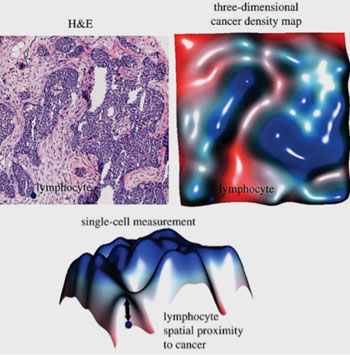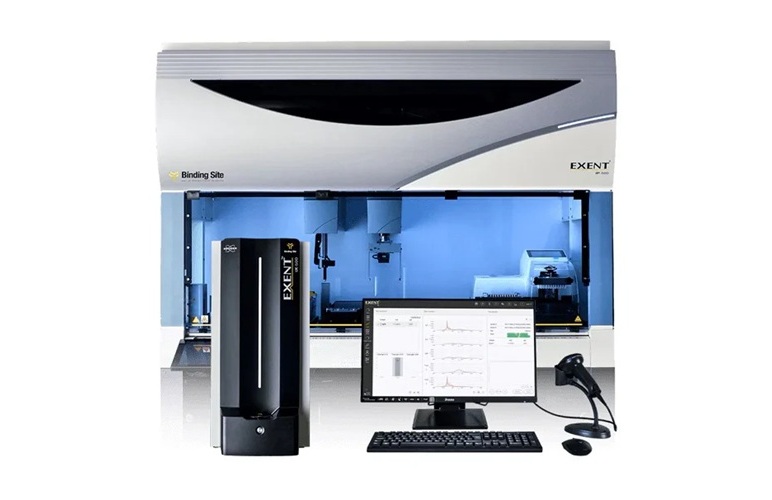Gene Expression Correlates with Lymphocyte Infiltration in Breast Cancer
|
By LabMedica International staff writers Posted on 30 Dec 2014 |

Image: A histology slide stained with hematoxylin and eosin (H&E) and the corresponding three-dimensional cancer density map, which facilitate the measurement of spatial proximity to cancer for every single lymphocyte in the image (Photo courtesy of The Institute of Cancer Research).
Lymphocytic infiltration is associated with a favorable prognosis and predicts response to chemotherapy in many cancer types, including the aggressive triple-negative breast cancer (TNBC).
A novel high-tech system has been developed for measuring the body's immune response to cancer as a way of assessing how rapidly the disease is likely to progress. The system combines computerized imaging of tumor samples with statistical analysis, and is the first objective method to measure the interaction between a patient's immune system and their tumor.
Scientist at The Institute of Cancer Research (London, UK) analyzed 181 samples from women with triple-negative breast cancer. On average, three tumor sections were obtained from different locations of each primary tumor and placed onto the same slide. Tumor materials sandwiched between these sections were sectioned, mixed and used for molecular profiling, thereby maximizing the biological relevance of multiple data types being generated.
The team developed a system, which split lymphocytes into three classes depending on their location within the tumor, and calculated how many of each type were present in each sample, and how many cancer cells were present. Immune infiltration was scored for 112 of the 181 samples by the pathologists into three categories: absent, mild and severe: absent if there were no lymphocytes, mild if there was a light scattering of lymphocytes and severe if there was a prominent lymphocytic infiltrate. Gene expression data were profiled using the human linkage-12 genotyping beadchip (HT-12) platform (Illumina; San Diego, CA, USA).
Women with fewer than around eleven intra-tumor lymphocytes per 1,000 cancer cells had an average five-year survival rate of 49%, compared with an average of 80% in triple-negative breast cancer as a whole. They also found a correlation between immune infiltration of tumors and increased levels of a protein called cytotoxic T-lymphocyte-associated protein 4, (CTLA4) or cluster of differentiation 152 (CD152), suggesting it could be a potential treatment target in this breast cancer type.
Yinyin Yuan, PhD, the team leader of the study, said, “Our test combines imaging technology with computerized analysis of large amounts of data from tumor samples, which typically contain more than 100,000 cells. We found the technique could accurately identify high-risk tumors that were evading the body's immune system in this type of breast cancer, and hope it can be adapted and added to doctors' arsenal against a variety of cancers.” The study was published on December 10, 2014, in the Journal of The Royal Society Interface.
Related Links:
The Institute of Cancer Research
Illumina
A novel high-tech system has been developed for measuring the body's immune response to cancer as a way of assessing how rapidly the disease is likely to progress. The system combines computerized imaging of tumor samples with statistical analysis, and is the first objective method to measure the interaction between a patient's immune system and their tumor.
Scientist at The Institute of Cancer Research (London, UK) analyzed 181 samples from women with triple-negative breast cancer. On average, three tumor sections were obtained from different locations of each primary tumor and placed onto the same slide. Tumor materials sandwiched between these sections were sectioned, mixed and used for molecular profiling, thereby maximizing the biological relevance of multiple data types being generated.
The team developed a system, which split lymphocytes into three classes depending on their location within the tumor, and calculated how many of each type were present in each sample, and how many cancer cells were present. Immune infiltration was scored for 112 of the 181 samples by the pathologists into three categories: absent, mild and severe: absent if there were no lymphocytes, mild if there was a light scattering of lymphocytes and severe if there was a prominent lymphocytic infiltrate. Gene expression data were profiled using the human linkage-12 genotyping beadchip (HT-12) platform (Illumina; San Diego, CA, USA).
Women with fewer than around eleven intra-tumor lymphocytes per 1,000 cancer cells had an average five-year survival rate of 49%, compared with an average of 80% in triple-negative breast cancer as a whole. They also found a correlation between immune infiltration of tumors and increased levels of a protein called cytotoxic T-lymphocyte-associated protein 4, (CTLA4) or cluster of differentiation 152 (CD152), suggesting it could be a potential treatment target in this breast cancer type.
Yinyin Yuan, PhD, the team leader of the study, said, “Our test combines imaging technology with computerized analysis of large amounts of data from tumor samples, which typically contain more than 100,000 cells. We found the technique could accurately identify high-risk tumors that were evading the body's immune system in this type of breast cancer, and hope it can be adapted and added to doctors' arsenal against a variety of cancers.” The study was published on December 10, 2014, in the Journal of The Royal Society Interface.
Related Links:
The Institute of Cancer Research
Illumina
Latest Molecular Diagnostics News
- First-Of-Its-Kind Automated System Speeds Myeloma Diagnosis
- Blood Protein Profiles Predict Mortality Risk for Earlier Medical Intervention
- First Of Its Kind Blood Test Detects Gastric Cancer in Asymptomatic Patients
- Portable Molecular Test Detects STIs at POC in 15 Minutes
- Benchtop Analyzer Runs Chemistries, Immunoassays and Hematology in Single Device
- POC Bordetella Test Delivers PCR-Accurate Results in 15 Minutes
- Pinprick Blood Test Could Detect Disease 10 Years Before Symptoms Appear
- Refined C-Reactive Protein Cutoffs Help Assess Sepsis Risk in Preterm Babies
- Blood Test Accurately Detects Brain Amyloid Pathology in Symptomatic Patients
- New Molecular Test Improves Diagnostic Accuracy of Lyme Disease
- New Genetic Test Enables Faster Diagnosis of Rare Diseases
- Urine Test Detects Inherited Neuropathy Missed by Genetic Screening
- Genomic Test Predicts Risk of SCC Metastasis
- Microfluidic Device Predicts Pancreatic Cancer Recurrence After Surgery
- New Molecular Test Simultaneously Detects Three Major Fungal Infections
- Blood Test Guides More Effective Ovarian Cancer Treatment
Channels
Clinical Chemistry
view channel
Chemical Imaging Probe Could Track and Treat Prostate Cancer
Prostate cancer remains a leading cause of illness and death among men, with many patients eventually developing resistance to standard hormone-blocking therapies. These drugs often lose effectiveness... Read more
Mismatch Between Two Common Kidney Function Tests Indicates Serious Health Problems
Creatinine has long been the standard for measuring kidney filtration, while cystatin C — a protein produced by all human cells — has been recommended as a complementary marker because it is influenced... Read moreMolecular Diagnostics
view channel
First-Of-Its-Kind Automated System Speeds Myeloma Diagnosis
More than 176,000 people are diagnosed with multiple myeloma worldwide each year, yet the current diagnostic pathway can be slow and uncertain, often relying on a highly subjective interpretation of test results.... Read more
Blood Protein Profiles Predict Mortality Risk for Earlier Medical Intervention
Elevated levels of specific proteins in the blood can signal increased risk of mortality, according to new evidence showing that five proteins involved in cancer, inflammation, and cell regulation strongly... Read moreHematology
view channel
Platelet Activity Blood Test in Middle Age Could Identify Early Alzheimer’s Risk
Early detection of Alzheimer’s disease remains one of the biggest unmet needs in neurology, particularly because the biological changes underlying the disorder begin decades before memory symptoms appear.... Read more
Microvesicles Measurement Could Detect Vascular Injury in Sickle Cell Disease Patients
Assessing disease severity in sickle cell disease (SCD) remains challenging, especially when trying to predict hemolysis, vascular injury, and risk of complications such as vaso-occlusive crises.... Read more
ADLM’s New Coagulation Testing Guidance to Improve Care for Patients on Blood Thinners
Direct oral anticoagulants (DOACs) are one of the most common types of blood thinners. Patients take them to prevent a host of complications that could arise from blood clotting, including stroke, deep... Read moreImmunology
view channel
Gene Signature Test Predicts Response to Key Breast Cancer Treatment
DK4/6 inhibitors paired with hormone therapy have become a cornerstone treatment for advanced HR+/HER2– breast cancer, slowing tumor growth by blocking key proteins that drive cell division.... Read more
Chip Captures Cancer Cells from Blood to Help Select Right Breast Cancer Treatment
Ductal carcinoma in situ (DCIS) accounts for about a quarter of all breast cancer cases and generally carries a good prognosis. This non-invasive form of the disease may or may not become life-threatening.... Read moreMicrobiology
view channel
Rapid Assay Identifies Bloodstream Infection Pathogens Directly from Patient Samples
Bloodstream infections in sepsis progress quickly and demand rapid, precise diagnosis. Current blood-culture methods often take one to five days to identify the pathogen, leaving clinicians to treat blindly... Read more
Blood-Based Molecular Signatures to Enable Rapid EPTB Diagnosis
Extrapulmonary tuberculosis (EPTB) remains difficult to diagnose and treat because it spreads beyond the lungs and lacks easily accessible biomarkers. Despite TB infecting 10 million people yearly, the... Read more
15-Minute Blood Test Diagnoses Life-Threatening Infections in Children
Distinguishing minor childhood illnesses from potentially life-threatening infections such as sepsis or meningitis remains a major challenge in emergency care. Traditional tests can take hours, leaving... Read more
High-Throughput Enteric Panels Detect Multiple GI Bacterial Infections from Single Stool Swab Sample
Gastrointestinal (GI) infections are among the most common causes of illness worldwide, leading to over 1.7 million deaths annually and placing a heavy burden on healthcare systems. Conventional diagnostic... Read moreTechnology
view channel
AI Saliva Sensor Enables Early Detection of Head and Neck Cancer
Early detection of head and neck cancer remains difficult because the disease produces few or no symptoms in its earliest stages, and lesions often lie deep within the head or neck, where biopsy or endoscopy... Read more
AI-Powered Biosensor Technology to Enable Breath Test for Lung Cancer Detection
Detecting lung cancer early remains one of the biggest challenges in oncology, largely because current tools are invasive, expensive, or unable to identify the disease in its earliest phases.... Read moreIndustry
view channel
Abbott Acquires Cancer-Screening Company Exact Sciences
Abbott (Abbott Park, IL, USA) has entered into a definitive agreement to acquire Exact Sciences (Madison, WI, USA), enabling it to enter and lead in fast-growing cancer diagnostics segments.... Read more









 Analyzer.jpg)












